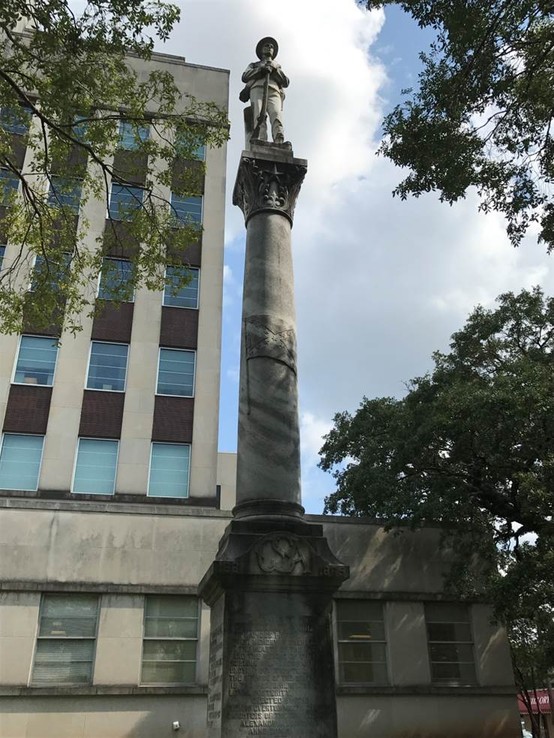Rapides Parish Confederate Monument
Introduction
Text-to-speech Audio
This Confederate monument in front of the Rapides Parish Courthouse was dedicated and funded by the United Daughters of the Confederacy in 1914 and placed at the courthouse in the 1960s. In March of 2017, a meeting of Alexandria City Council members discussed the possible removal of the monument. However, because the monument is owned by the UDC, it was decided at that time that the monument could not be removed by the city. As of 2021, that decision has been challenged but the monument has not been removed despite a resolution from the city council supporting removal from public property.
Images
The "Pride of Alexandria" Confederate monument

Backstory and Context
Text-to-speech Audio
The local UDC chapter was responsible for erecting the statue, which coincided with a wave of monument building in the former Confederate states. As several historians explain, the UDC promoted a Lost Cause ideology as an explanation for the Southern defeat during the Civil War between 1861 and 1865. A generation removed from the conflict, beginning in the 1890s, women formed many organizations to promote a pro-South explanation for the South's rebellion and subsequent military defeat. The UDC worked with other memorialization organizations to place statues in towns across the South and with clergymen to promote a southern interpretation of what was then recent history in Sunday schools and eventually in the South's all-white public schools.
The Rapides Parish monument to the Confederacy and the UDC's memorialization of Confederate soldiers as heroes also occurred at the same time that a wave of racial violence gripped the South. Louisiana was especially violent from the 1880s to the early 1920s, particularly in the central and north-central portions of the state.
The Confederate statue in the middle of Alexandria, Louisiana is a 100-foot tall, zenith gray stoned statue. Inscribed on the monument, the UDC had the following words emblazoned upon it: “Dedicated to the Confederate soldiers of Rapides Parish. Their memory is enshrined in the hearts of the people and the record of their sublime self-sacrifice and undying devotion to duty, and the service of the Southland is the proud heritage of a loyal posterity.” Few, if any, Confederate monuments document what white Southerners really fought for, and that was the expansion and perpetuation of race-based slavery.
Coupled with the racial violence of the era, the Rapides Parish Confederate statue is another symbol of the South's connections to slavery and secession. Records demonstrate that this was the intent of the monument's early supporters. On August 27, 1910, a memo was posted in the Alexandria Town Talk that there would be a monument in memory of the departed Confederate Veterans who fought in the American Civil War, and it would be known as the “Pride of Alexandria.” The monument was first placed at the City Hall square at Third and Murray Streets. In 1962--during statewide celebrations all across the South for the 100-year anniversary of the Civil War--a new city hall building was opened, and the monument was moved from its original spot to the new location. When the monument reached its new home, it had been turned to face north rather than south as it was in its first spot. In 1973, white residents of Alexandria and Rapides Parish turned out for a ceremony to take place to honor Confederate Memorial Day--a state holiday active in many, if not all, of the former Confederate states. Residents decorated the monument, and a parade rolled through town celebrating its connection to slavery and secession.
The off-the-schedule ceremony took place in June of 1973, preceding the lengthy parade that was accompanied by speeches from John Overton and a presentation by Mrs. Ada Hale Johnson, the president of the UDC chapter. The biggest highlight of the unveiling ceremony was the presentation of the old battle flag from the Cheneyville Rifles to the UDC chapter by Col L. B. Claiborne.
In March of 2017, a meeting of Alexandria City Council members discussed the possible removal of the monument. However, because the monument rests on land owned by the UDC, it was decided at that time that the monument could not be removed by the city.
Sources
1. Ben Myers. “Confederate Monument Fight Brewing in Alexandria.” NOLA.com/Times-Picayune, Mar. 14, 2016, www.nola.com/politics/index.ssf/2016/03/Confederate_monument_fight_bre.html.
2. “A Confederate Monument.” The Alexandria Town Talk, 1910, 2–2.
3. Karen L. Cox. "Women, the Lost Cause, and the New South: The United Daughters of the Confederacy and the Transmission of Confederate Culture, 1894-1919." unpublished Ph.D. dissertation. University of Southern Mississippi. Hattiesburg, MS, 1997.
4. Charles Reagan Wilson. Baptized in Blood: The Religion of the Lost Cause, 1865-1920. Athens: University of Georgia Press, 1980, 1-17.
5. Monroe Work Today. Tuskegee University. http://www.monroeworktoday.org/
